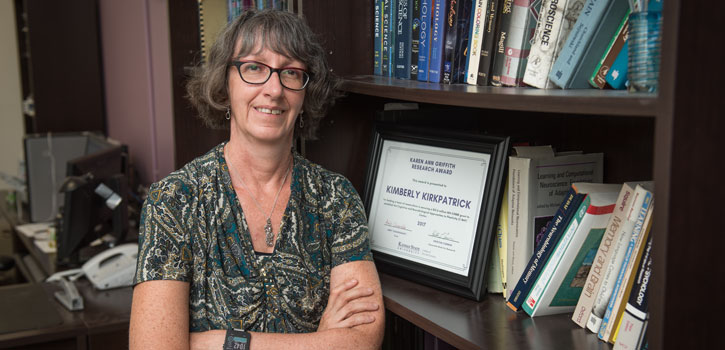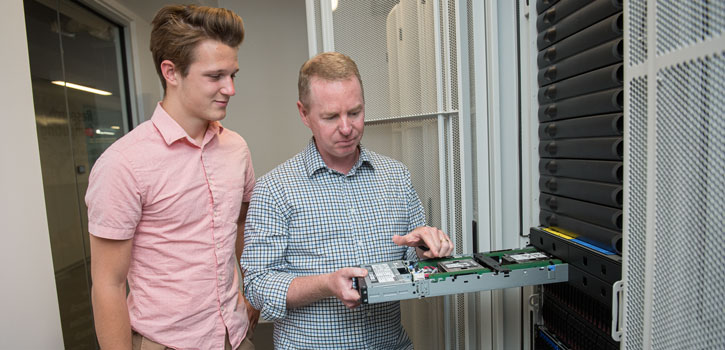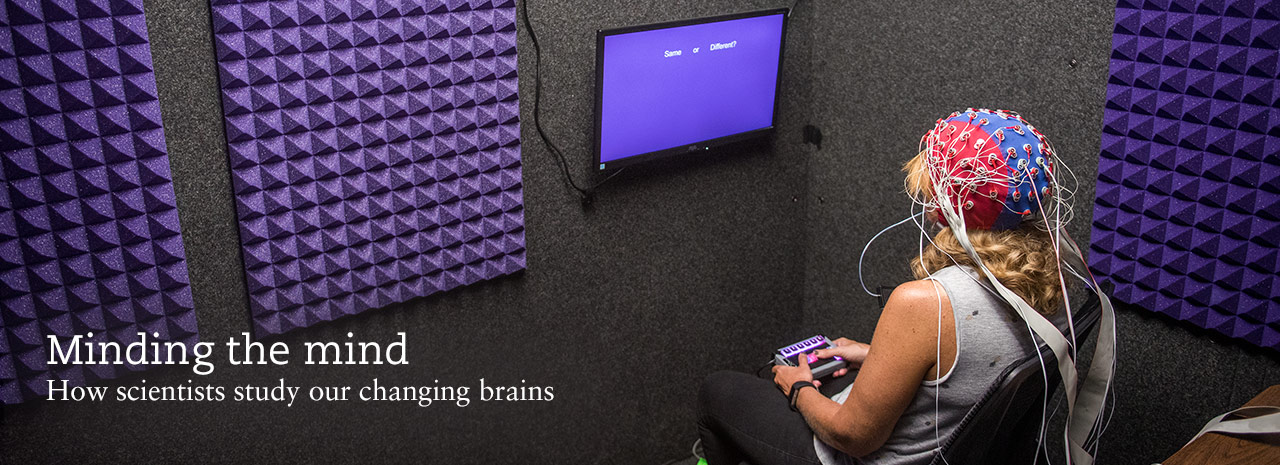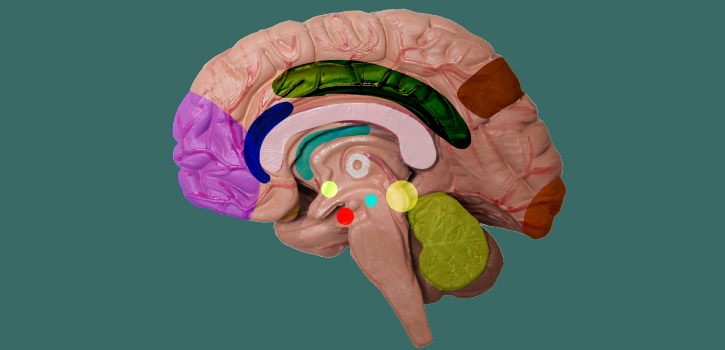Minding the mind: How scientists study our changing brains
By Jennifer Tidball
We can see plasticity in the world around us.
It might look like this: A student studying for a test. An adult adjusting to a hearing aid. A driver trying to remember where the car is parked. A zebrafish memorizing a place with tasty food. A rat learning self-control.
Plasticity is how the brain changes with experience, learning or age. It can be a positive change, such as a child learning the alphabet or an adult choosing a salad instead of cake. But plasticity also can have a negative side, such as a person struggling with alcohol abuse or suffering from a degenerative disease.
“Plasticity can be good and it can be bad, but both are important and that’s why we need research on both sides of the coin,” said Kimberly Kirkpatrick, Kansas State University distinguished professor of psychological sciences. “It’s important to understand why the brain changes because it can help with disease treatment or countermeasures.”
Plasticity is the research focus of the Kansas State University Cognitive and Neurobiological Approaches to Plasticity Center, or CNAP.
CNAP is a statewide effort led by K-State to help us understand our changing brains and improve our quality of life. While the center is housed in the K-State psychological sciences department, it involves interdisciplinary researchers from the College of Arts and Sciences, the Carl R. Ice College of Engineering and the College of Veterinary Medicine. CNAP also includes collaborators at the University of Kansas and Wichita State University.
The National Institutes of Health recognizes the importance of neuroscience research and, in 2017, funded CNAP with a prestigious $10.6 million Centers of Biomedical Research Excellence, or COBRE, grant. It is the largest grant in the history of the psychological sciences department and is only the second time the university has received a COBRE grant. Now early in its third year, the center continues to develop and grow.
“What we have been able to do in two years is huge,” said Kirkpatrick, CNAP director. “The enrichment to our research community is substantial and our faculty members are able to take their work to the next level.”
More than 63 collaborators — including faculty members, scientists, postdoctoral researchers, graduate students and undergraduate students — are involved with CNAP and are conducting cognitive, behavioral and neurobiological research on topics such as self-control, alcohol abuse, aging, hearing, memory loss and learning.
“Our areas of research are diverse, but plasticity is really the glue that holds it all together,” Kirkpatrick said. “Everything relates to brain processes, brain health and plasticity in terms of changes that happen in the brain over time or with experiences.”
In addition to supporting research, the grant also has funded laboratory upgrades, including a surgery unit, a new histology laboratory and other equipment. The renovations total more than 2,100 square feet in Bluemont Hall and the upgrades have led to new research possibilities.
“These significant improvements in our infrastructure have opened the door to people performing techniques they couldn’t do before,” Kirkpatrick said. “Facilities matter in neuroscience, and now we can recruit top-of-the-line faculty, graduate students and postdoctoral researchers.”
Understanding the brain

For her own research, Kirkpatrick is using the upgraded facilities to study two areas: ways to improve self-control and ways that diet affects the brain and impulsive behavior.
Self-control is associated with many positive behaviors. People with good self-control are less likely to abuse drugs, are less likely to have attention disorders, are more likely to maintain healthy weight and are more likely to have better financial management.
Kirkpatrick is studying behavior in rats and humans to understand how self-control affects the brain. Through time-based interventions, Kirkpatrick’s team has found that rats prefer to wait for a larger treat rather than have a smaller treat immediately. Now the team is doing similar behavioral work with humans through computer games, activities and smartphone apps that help people practice self-control.
Through diet-related research, Kirkpatrick has found rats that eat high-fat and high-sugar diets are more likely to engage in impulsive behavior.
“These high-fat or high-sugar diets are causing inflammation in the brain and that’s causing damage to cells,” Kirkpatrick said. “Even with a return to a healthy diet, some individuals still have nervous system damage that’s changing their cognitive behavior long term.”
As a result, Kirkpatrick’s team is looking at ways to help combat neuroinflammation with omega-3 supplements.
“We are developing interventions that promote decisions that lead to health and prosperity,” Kirkpatrick said.
The aging brain

As we age, we naturally experience cognitive declines. We might forget where we parked our car or what we had for breakfast yesterday. But we also gain more experience and knowledge.
Heather Bailey, assistant professor of psychological sciences, thinks that is important. She is studying how older adults can use their experiences and knowledge to learn new information.
Her project has two groups of people — adults ages 65 to 85 and adults ages 18 to 28 — watch a series of videos that depict everyday activities, such as cooking breakfast, balancing a checkbook or working with technology. Bailey uses eye tracking technology to determine what people pay attention to and uses fMRI, which stands for functional magnetic resonance imaging, to determine what parts of the brain are involved in learning and remembering new information.
“We are finding that when people have relevant knowledge, they are better able to remember the activity in the video,” Bailey said. “However, if they don’t have any relevant knowledge, then chunking the activity into smaller events can improve their memory.”
More than 200 people have participated in this study either on the K-State Manhattan campus or at the Hoglund Brain Imaging Center with the University of Kansas Medical Center.
Bailey is planning further work with people suffering from early onset Alzheimer’s disease or other neurodegenerative diseases.
“Our research could help improve older adults’ quality of life and help them function independently longer,” Bailey said.
But what happens before we age? Can our childhood environments affect our brains as adults?
That’s what Mary Cain, professor of psychological sciences, aims to understand. She studies how childhood environments affect alcohol and drug use in adults.
Through her work with rodent models, she has found that rats raised in an enriched environment with toys and social interaction have lower drug and alcohol intake as adults. Cain also has found that rats raised in an enriched environment are very sensitive to the taste of alcohol and sugar water.
“We know that the early rearing environment causes brain changes, but it’s really novel that it also may be altering taste,” Cain said. “That may have implications for alcohol use in adulthood as well.”
By looking at images of the brain, Cain can better understand how the structure of the brain, specifically parts of the nerves themselves, can affect alcohol use in adulthood. Her work also applies to humans.
“Our research shows that any kind of enrichment provided during childhood is protective against drug and alcohol use in adulthood, and that’s a result of plasticity changes,” Cain said. “Early life enrichment is really important.”
Comparing the brain

One of the best model species for studying the human brain is a small, 2-inch minnow: the zebrafish. That’s because about 75% of human genes also are found in zebrafish and about 84% of human disease genes have a counterpart in zebrafish.
“This shared genetic setup makes zebrafish a fascinating model for studying human affective disorders and the neural basis of affection, emotion and cognition,” said Thomas Mueller, research assistant professor in the Division of Biology.
Specifically, Mueller studies the amygdala, which is the part of the human and fish brain that controls emotion and mediates social behavior and associative emotional learning, such as fear learning. Mueller focuses on two neurological disorders that are affected by the amygdala: autism spectrum disorders and post-traumatic stress disorder.
“We like to think that only humans and maybe our pets have emotions,” Mueller said. “But my research shows that the neurocircuits and the amygdala of the zebrafish are not only very complex, but also stunningly similar to the mammalian brain, much more similar, in fact, than previously imagined.”
Mueller’s research group is now using a CNAP pilot grant and part of a $1.3 million Human Frontier Research Foundation grant for an international collaboration to better understand how spatial and associative learning are organized in zebrafish and other fish.
Imaging the brain

But important functional and anatomical brain research is only as good as the images you can capture.
In fact, CNAP has fostered collaboration in new imaging technologies. As part of the center’s mission, Mueller and Cain are working with Stefan Bossmann, university distinguished professor of chemistry. Bossmann’s team specializes in state-of-the-art imaging of neurons using a National Science Foundation-funded instrument called an fMRI, which analyzes chemical compounds in the brain.
The partnership also involves Punit Prakash, the Paul L. Spainhour professor in the Mike Wiegers Department of Electrical and Computer Engineering, who is creating better ways to evaluate the images and data.
Bossmann uses a 600-megahertz MRI to capture incredibly detailed images — around 100 micrometers in resolution — of the zebrafish and rodent brains to show what parts of the brain are activated in specific situations. The technique is called diffusion tensor imaging, or DTI, and measures the signaling between neurons. The technique also can benefit people with diseases such as multiple sclerosis because it can determine what neurons are or are not working.
“This kind of functional imaging is very rarely done, and it is not done to the resolution that we have,” Bossmann said.
The high-resolution MRI images allow Mueller to create data-rich 3D functional atlases of zebrafish brains. Cain uses the images to study how substances in the brain, specifically myelin, may increase resistance to alcohol abuse.
Bossmann, who also works with the K-State Johnson Cancer Research Center and the Center of Excellence for Pancreatic Cancer Research, uses MRI for tumor research. It was natural for Bossmann to get involved with CNAP, too.
“I am able to collaborate with the team to develop new methodologies and make them available to the community,” Bossmann said. “The research can give important insight into therapeutic targets.”
Training the brain

As our brains process sights and sounds, CNAP scientists use EEG to show neural activity as it is happening. With EEG, short for electroencephalography, participants wear a special cap with noninvasive electrodes that detect electrical activity in the brain.
Matthew Wisniewski, assistant professor of psychological sciences, and Alexandria Zakrzewski, research assistant professor of psychological sciences, are developing new EEG facilities to study how our brains process what we see and what we hear.
Wisniewski studies auditory learning and his work aims to train people to hear new details in sound. For his projects, people wear an EEG cap while they are in a sound booth listening to sounds through earphones. The EEG provides a measurement of how the brain reacts to sound before and after training exercises, as well as the extent to which individuals put effort into listening.
“We’re measuring their ability to hear details in sound over the course of training,” Wisniewski said. “We want to know what types of training are most effective for changing the brain and improving listening performance. These procedures can then be used to train listening skills with hearing aids or cochlear implants.”
Zakrzewski’s research focuses on metacognition, which is how we think about our own thinking. Her work can help people who are struggling with addiction or who might have poor cognitive ability and not know they are struggling.
“Metacognition is really useful for how we might monitor our judgments and control our behavior,” said Zakrzewski, who also leads the EEG facility. “I’m interested in metacognitive accuracy, or how well we know when we’re right or wrong.”
Zakrzewski has participants make confidence ratings during perceptual or memory tasks and uses EEG imaging techniques to capture metacognition in the brain. She is building training programs to help people improve their metacognitive abilities so they can change or adjust their behaviors.
Informing the brain

The research generated from the large amounts of EEG data and high-resolution images of the brain requires a lot of computer power.
Enter Beocat, the high-performance computing cluster at K-State. Beocat is the most powerful supercomputer in Kansas and is 4,000 times more powerful than the average laptop.
“Research is becoming dominated by big data and interdisciplinary teams, and CNAP is a model for this type of interaction,” said Dan Andresen, professor of computer science and director of the Institute for Computational Research. “You can have the best ideas and the best researchers, but they aren’t going to get their research done unless they have an environment that can handle it.”
Beocat’s large processing capacity already has made a difference for CNAP research: Data analysis that used to take days can now be done in hours. Researchers can easily crunch numbers and transfer data to collaborators.
K-State computer scientists are developing new analytic methods for the massive amounts of data and images that CNAP researchers collect. Computer science graduate and undergraduate students often partner with the psychological sciences and biology researchers to develop new programs that work quickly and efficiently.
“It is a great experience for these computer science students because they are taken out of their engineering bubble and get interdisciplinary real-world experience,” Andresen said. “Science is becoming more digitized and more data dependent. That’s where we come in.”
A collaborative team
The Kansas State University Cognitive and Neurobiological Approaches to Plasticity Center, or CNAP, is a statewide effort that involves more than 63 interdisciplinary collaborators from multiple institutions. Here is a list of some of the grant participants.
Directors and advisers
Kimberly Kirkpatrick, Kansas State University, PI/PD behavioral neuroscience core director
Lester Loschky, Kansas State University, associate director
Daniel Andresen, Kansas State University, neuroinformatics core director
Alexandria Zakrzewski, Kansas State University, electroencephalography core director
Mark McCourt, North Dakota State University, external advisory committee chair
Peter Balsam, Columbia University, external advisory committee member
Rebecca Burwell, Brown University, external advisory committee member
Rhonda Lewis, Wichita State University, internal advisory committee member
Beth Montelone, Kansas State University, internal advisory committee member
Brian Spooner, Kansas State University, internal advisory committee member
Michael Young, Kansas State University, internal advisory committee member
Mentors
George John Anderson, University of California-Riverside, project mentor
Stephan Bossmann, Kansas State University, project and pilot grant mentor
Alex Chaparro, Embry-Riddle Aeronautical University, project mentor
Ann Davis, University of Kansas Medical Center, pilot grant mentor
Joseph Donnelly, University of Kansas, pilot grant mentor
Andrew Holmes, National Institute on Alcohol Abuse and Alcoholism, project mentor
Stephen Kiefer, Kansas State University, project mentor
Kimberly Kirkpatrick, Kansas State University, project mentor
Lester Loschky, Kansas State University, project mentor
Laura Martin, University of Kansas Medical Center, project mentor
Yavin Shaham, National Institute on Drug Abuse, project mentor
Philine Wangemann, Kansas State University, pilot grant mentor
Jeffrey Zacks, Washington University-St. Lewis, project mentor
Grantees
Heather Bailey, Kansas State University, project lead
Mary Cain, Kansas State University, project lead
Rui Ni, Wichita State University, project lead
Charles Pickens, Kansas State University, project lead
Amanda Bruce, University of Kansas Medical Center, pilot grant lead
Thomas Mueller, Kansas State University, pilot grant lead
Yulan Xiong, Kansas State University, pilot grant lead
Barbara Pitts, Kansas State University, postdoctoral fellow
Ryan Ringer, Wichita State University, postdoctoral fellow


